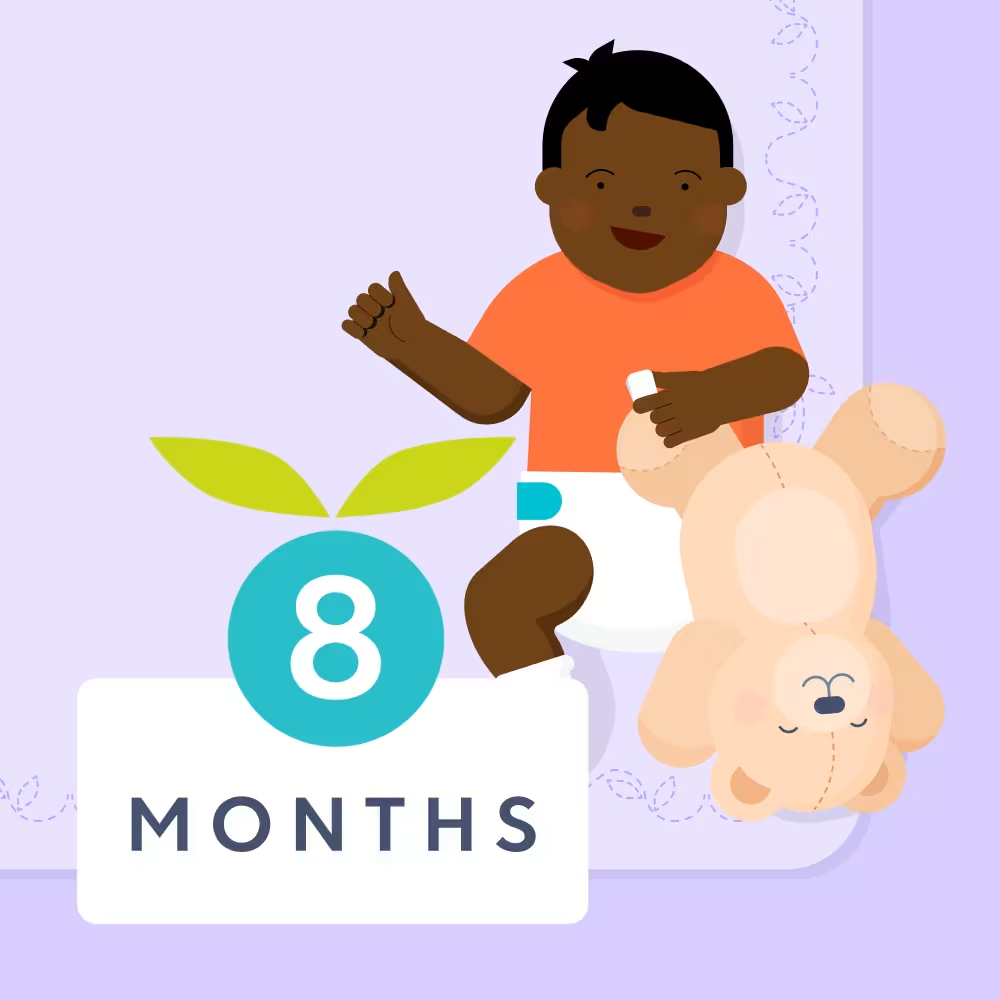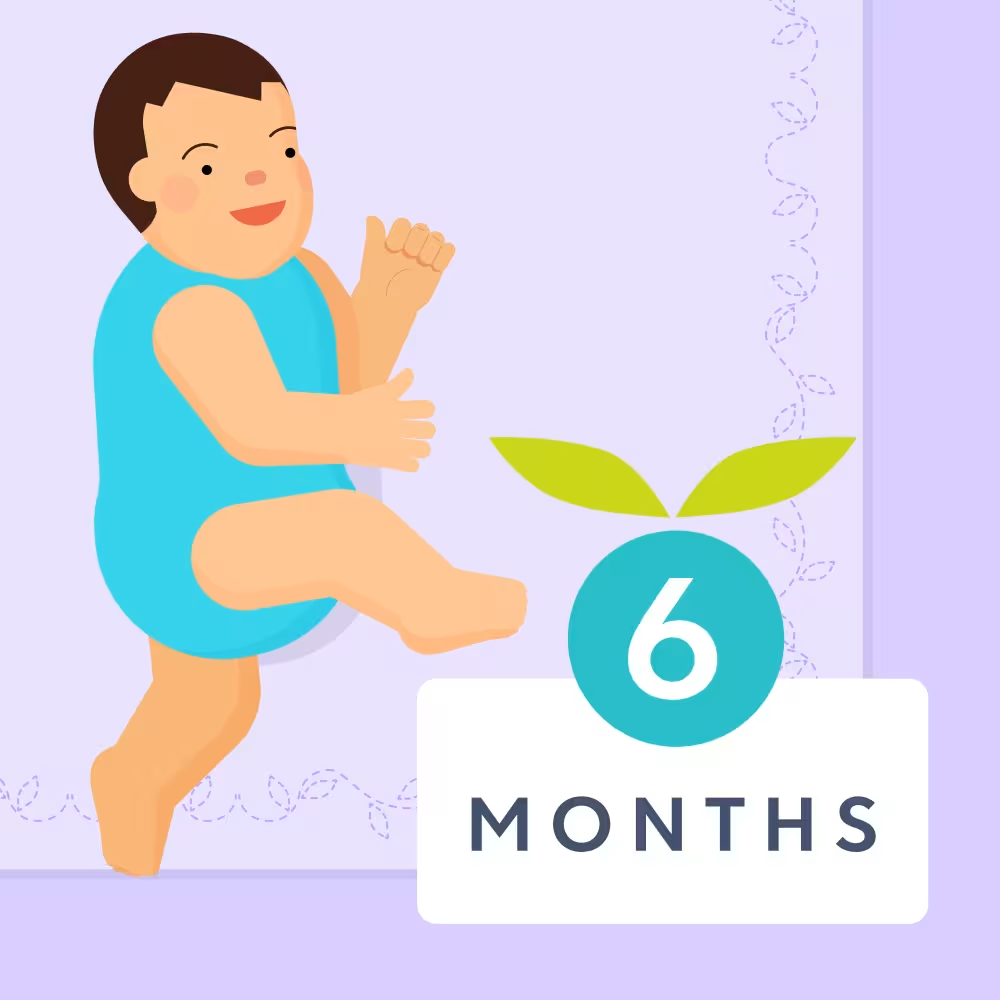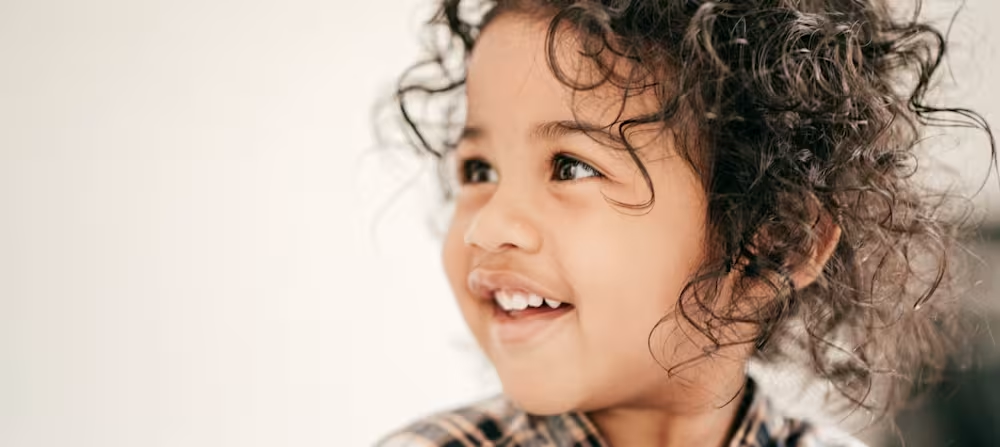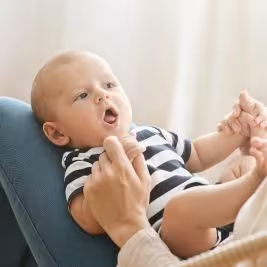When do babies stand for the first time?
Updated Dec 29, 2025

Standing is an exciting motor milestone as it’s a big step on the way to your little one’s first steps! Being upright on two feet also gives your little one a new way to look at their world after spending so much time crawling and sitting on the ground. When children start standing, they don’t seem like such tiny babies, which can be bittersweet for parents.
In this article, we’ll give you an idea of when your infant may start standing, give you tips for encouraging this skill, and provide information on what comes next.
Editor's note
When we discuss babies and development at Huckleberry, we use their adjusted age (vs. actual age). It’s expected that infants will reach physical milestones at different times — there’s a wide range of normal when it comes to how fast little ones grow and develop. However, you know your baby best. If you have any concerns or questions about your child’s development, reach out to their pediatrician.
When do babies start standing?
You may be eagerly awaiting the day when your little one can stand, which is an exciting milestone that precedes their first steps. It’s important to remember that standing requires leg, core, and hip strength and happens in different phases and typically progresses from pulling to standing (supported standing) to unsupported standing.
Also note that it's important to let your child work on the skill of standing on their own, when they have the strength and coordination to do so. We don't recommend putting a child in a standing position before they're ready. Instead, aim to encourage your baby to work on crawling. Crawling can strengthen their legs and core and them learn how both sides of their body works together, which helps with fine and gross motor skills down the line, including cruising, reaching in standing, and walking.
When do babies stand with support?
Babies can usually stand with support at around 7 - 12 months []. This typically looks like a child pulling themselves [] up into a standing position (called “pulling to stand”) by holding onto a sturdy piece of furniture or step stool.
When do babies stand without support?
After the pull-to-stand milestone, you may expect your little one to be able to stand independently (meaning balancing on their two feet while not holding onto a person or piece of furniture) somewhere between 9 - 12 months []. Even when they can stand independently, it will usually take a few more months for them to be able to stay in a standing position for more than a couple of seconds. Babies may not be able to stand on their own for longer than this until closer to 13 - 15 months [].
There’s a wide range of normal when it comes to physical development. Your little one may or may not achieve this standing milestone in the age ranges listed above and that’s OK! Be sure to consult their pediatrician if you have concerns about their development.
Why do babies stand?
Remember the phrase, “You have to walk before you run”? Well, children typically learn to stand before they can walk! Standing is an important phase that comes before walking [] and helps to improve the control of the leg, hip, and core muscles. Standing can also help improve balance and coordination [] needed for future motor skills.
Ways to encourage baby standing?
Tip #1: Get moving
In order to stand, babies need to have strong legs, hips, and core muscles []. This strength often comes from engaging in other motor skills, like sitting, rolling, and crawling. To help prepare your little one for standing, give them as much time and space as possible to practice these skills.
Tip #2: Move toys from the floor to an elevated surface
Placing toys from the floor to a low, secure surface (like a couch) can encourage your child to pull themselves up into a standing position to follow the toys. Note that if the couch or other surface is too high, your kiddo may need to gradually work their way to this height. If this is the case, try placing toys on something a little lower at first, like a sturdy step stool. Playing in a standing position can then increase your child’s strength and balance, which will be used for independent standing, then walking.
Tip # 3: Give baby a toy to hold while standing
Babies are often wobbly while learning to stand independently and giving them a toy to hold onto [] in this position may help to stabilize them. One small study suggests [] that babies were able to stand much longer when holding a toy (12.09 seconds when holding a toy, 4.71 seconds when not holding a toy).
Tip #4: Play with babies who are able to stand
Being around other babies of similar age who are already able to stand [] may help encourage your little one to do it too. Babies can learn new skills and body movements through imitation [].
Tip #5: Expect falls
Falling is a normal part of the learning process. While you can do your best to offer a hand and support while they’re learning to stand, expect that falls will happen []. Try your best to always be within reach, practice on soft surfaces, and keep your baby away from hard objects to avoid injury. Most of the time, babies get right back up after plopping down!
Baby not standing: What to do
If your baby is not standing yet (supported or unsupported), note that there’s a wide range of normal when it comes to when a child will be able to stand and not all children will reach developmental milestones at the same time. Some babies may just need a little extra time to master gross motor skills. The American Academy of Pediatrics [] recommends letting your child’s doctor know if they are not standing with support by 12 months.
However, you know your little one best! If they are not meeting other milestones, have lost skills they once had, or notice any developmental red flags, share your concerns with their pediatrician.
While there are plenty of ways you can help encourage your little one to reach this motor milestone, the AAP strongly advises [] that you do not use a baby walker to try to help your child stand and/or learn to walk due to some very serious safety risks. Note that a baby walker is different than a push toy (or "push walker"). A baby walker is a container with wheels that you put a baby in and they are able to "walk" on their own. They are banned in many countries as they pose serious safety risks, especially if there are stairs or dangerous items that can be reached when a child is in the walker. A push toy or "push walker" is a sturdy toy that a child can use to pull themselves into a standing position and then push from behind.
Standing unlocked: What's the next step?
After learning to stand with support, this skill often progresses to a child being able to turn and look at something with just one arm supporting them as they continue to build strength and balance. Then comes standing independently, with hands-free from support objects.
Once a baby is able to stand on their own, you might expect them to start “cruising,” or moving along a piece of furniture while using it for support. As they do this more frequently, their confidence and speed will grow. This cruising phase often comes before a child is ready to walk while holding onto an . From here, they’re well on their way to those very exciting first independent steps!
Takeaway
Children often learn to stand with support at around 7 - 12 months and learn to stand independently at around 9 - 12 months. Of course, there’s a wide range of normal when it comes to motor milestones and it’s OK if your little one achieves this milestone before or after the expected range.
Standing requires leg, hip, and core strength. To help your child learn to stand, encourage them to practice other motor skills like sitting, crawling, and rolling. Also, try giving your little one a toy to hold onto when they’re standing independently as this may help them stay in the position a few seconds longer.
Supported standing usually comes before independent standing. From there, children typically start cruising along furniture before they’re ready to take a few steps while holding onto an adult with two hands. From there, the foundation is set for their first solo steps!
The AAP recommends that you let your child’s pediatrician know if they are not standing with support by 12 months. If you have any concerns or questions about your baby’s development before their 1-year well-baby visit, be sure to address them with their doctor.
Baby standing: FAQs
Share article:
Note: The content on this site is for informational purposes only and should not replace medical advice from your doctor, pediatrician, or medical professional. If you have questions or concerns, you should contact a medical professional.









